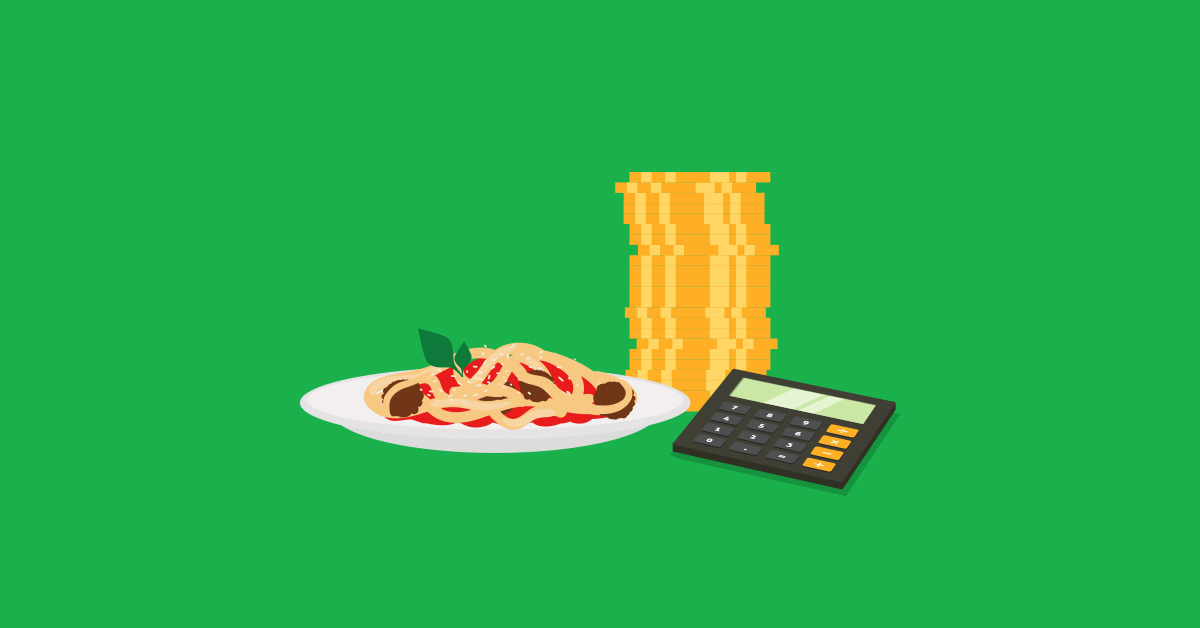
Having a great new recipe might not mean much if you don’t have the right pricing to go along with it. Whether it’s working on a new spin on a classic dish, or coming up with a unique creation, recipe building is an essential part of running a restaurant. A lesser known, but equally important part of recipe building is recipe costing. This practice gives you the information you need to make critical decisions about your menu and inventory and really get down into the nitty gritty of your individual dishes.
Proper recipe costing can even mean the difference between profitability and closing up shop. In this blog, we’ll walk you through the basics of calculating your recipe costs and making your costing process more efficient.
- What is recipe costing?
- Why is recipe costing important?
- How to start costing your ingredients
- Recipe costing formulas
- Calculating your ideal menu price
- Optimizing your restaurant through recipe costing
Calculate your food costs with our free food cost calculator.
Find out the total cost of the dish, markup amount, profit per sale and how much to charge your customers.
What is recipe costing?
Recipe costing is the process of taking apart a menu and calculating the individual cost of each ingredient used for a specific dish. The added cost of each ingredient used will equal your total cost for a dish. When you know the exact cost of making each dish, you’ll be better equipped to price your menu items.
Why is recipe costing important?
Running a restaurant successfully isn’t just about the quality of the food. It’s also about being meticulous in controlling your margins, costs and prices. In an industry where products expire and markets are saturated, keeping tight control over costs will likely define your restaurant’s ability to reach profitability. Diligent recipe costing gives more control over your inventory and how much you’re spending to create your menu.
How to start costing your ingredients
The costing process can be as granular or as high level as you’d like, but keep in mind that the more detailed the process, the better the information you’ll have to make smarter pricing decisions.
Main steps to recipe costing
- Do a preliminary inventory count
- Write down your menu dishes and work on your costing dish by dish
- Choose a dish and list out the ingredients used with specific quantities (use specific units of measurement)
- Write down the wholesale cost for each ingredient and calculate the cost per specific unit of measurement from there
Recipe costing example
Let’s take a burger as an example. If a restaurant wants to find out what the cost of their burger is, first they need to list out the ingredients and their quantities. In this example the burger consists of 6 ounces of ground beef, 1 potato bread bun, 1 slice of cheese, 2 slices of tomatoes, 3 pickle slices and 1 tablespoon of sauce.
In order to figure out the cost of the burger, first cost out each ingredient. If you purchase 7 pounds of ground beef for $28 dollars, and one pound of ground beef equals 16 ounces, this means that each ounce of ground beef is $0.25. If you multiply $0.25 by 6 (the amount of ounces used in your burger you’ll get your cost of $1.5 for the ground beef in your recipe. You’ll have to do this exercise for each ingredient in your dish.
- 6 ounces of ground beef = $1.5
- 1 potato bread bun = $0.30
- 1 tbsp. of sauce = $0.20
- 2 slices of tomatoes = $0.50
- 1 slices of cheese = $0.50
- 3 pickle slices = $0.60
Now you just need to add the cost of each ingredient to get the total. For this burger, the total cost of the dish is $3.6.
Recipe costing formulas
An important concept to keep in mind when taking a deep dive into your recipes and food costs is your food cost percentage. This percentage measures the relationship between the cost of ingredients and the revenue that those ingredients bring to your restaurant.
Food cost percentage will range from restaurant to restaurant, depending on the cost of their ingredients and how much they price their dishes. Most restaurants will aim for a food cost percentage between 28-35%. The main goal, however, is to keep your food cost percentage low to ensure bigger margins—without sacrificing quality of course.
In order to calculate your food cost percentage, you’ll need to look at your overall inventory costs and your food sales.
With this formula you’ll be able to get a holistic picture of your performance and where your food costs fall under that.

Lowering your food cost percentage
If one of your goals is to increase your margins, one way to do that would be to lower your food cost percentage. This can be done in several ways:
Increasing your prices
This allows you to keep using your existing ingredients and quantities, without reducing quality. While sometimes this might be necessary, you need to also analyze what your customer base is willing to pay.
Changing suppliers
Reducing costs can sometimes be as simple as finding new food vendors and looking for workarounds in your food supply chain.
Reducing portion sizes
If increasing costs doesn’t work for your existing customer base, reducing portion sizes, or changing dishes slightly to accommodate your existing price, can be an option that keeps everyone happy.
Using alternative or more affordable ingredients
While this option might mean your dish quality takes a direct hit, it can be a good alternative if you want to keep your dish size and price the same. This is a good opportunity to get creative with ingredients and find similar ingredients that will lower your overall dish cost.
Using technology to automate your inventory
Sometimes all it takes to lower your food costs is having the right tools by your side. Automation gives you data directly linked to your inventory and sales that’ll show you opportunities on where you can reduce food waste and lower costs.
Calculating your ideal menu price
While there are many ways to calculate your ideal price, using your ideal food cost percentage is a great way to find a price that keeps your food cost ratio low.
Using your ideal food cost percentage, use the following formula to get your ideal price.

Using our original burger example, if your burger cost costs $3.6 to make and you’re aiming to keep your food cost ratio low at 28%, your calculation would be as follows:
3.6 / .28 = 12.86
Your ideal menu price would be $12.86, since this price would keep your food cost percentage at your goal of 28%. If you’re looking to lower your existing percentage, this formula will give you an idea of how much you need to raise your prices to get your desired percentage.
Another alternative can be working back to your price by using a gross profit margin formula. This formula looks at both your cost of goods sold and revenue. For financially viable restaurants, gross profit floats around 70%.
Gross profit margin formula

Optimizing your restaurant through recipe costing
Recipe costing can open the door to smarter decisions around pricing, inventory and waste. Costing your ingredients will always involve some level of manual counting, but it doesn’t need to be labor intensive.
The first step towards optimizing your costing process is opting for an automated inventory management system. An inventory system that’s integrated with your restaurant point of sale can free up hours of time for you and your staff and can give you additional data around your menu. You’ll be able to see accurate inventory counts with real-time automated replenishments and deductions. By knowing exactly how much you have on hand and how much you need to order, you’ll be able to keep better track of your inventory and reduce food waste and food costs.
Get started automating your inventory and reducing your food costs today. Talk to one of our experts to find out how Lightspeed can help.

News you care about. Tips you can use.
Everything your business needs to grow, delivered straight to your inbox.


